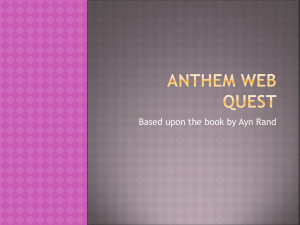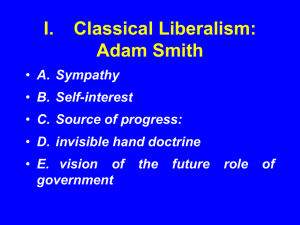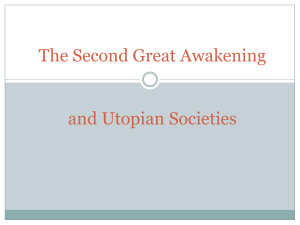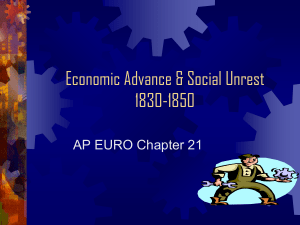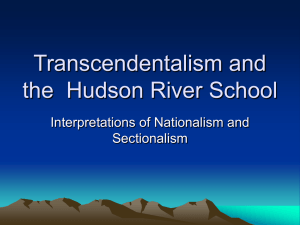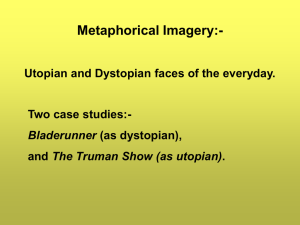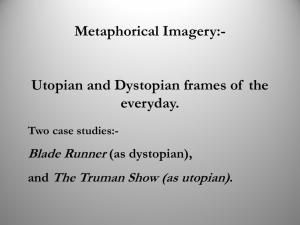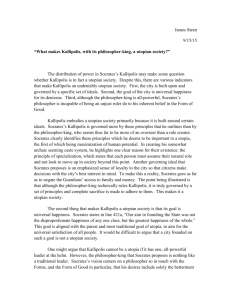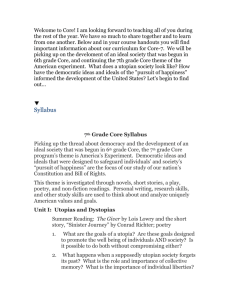The Utopian Impulse in Contemporary Art
advertisement
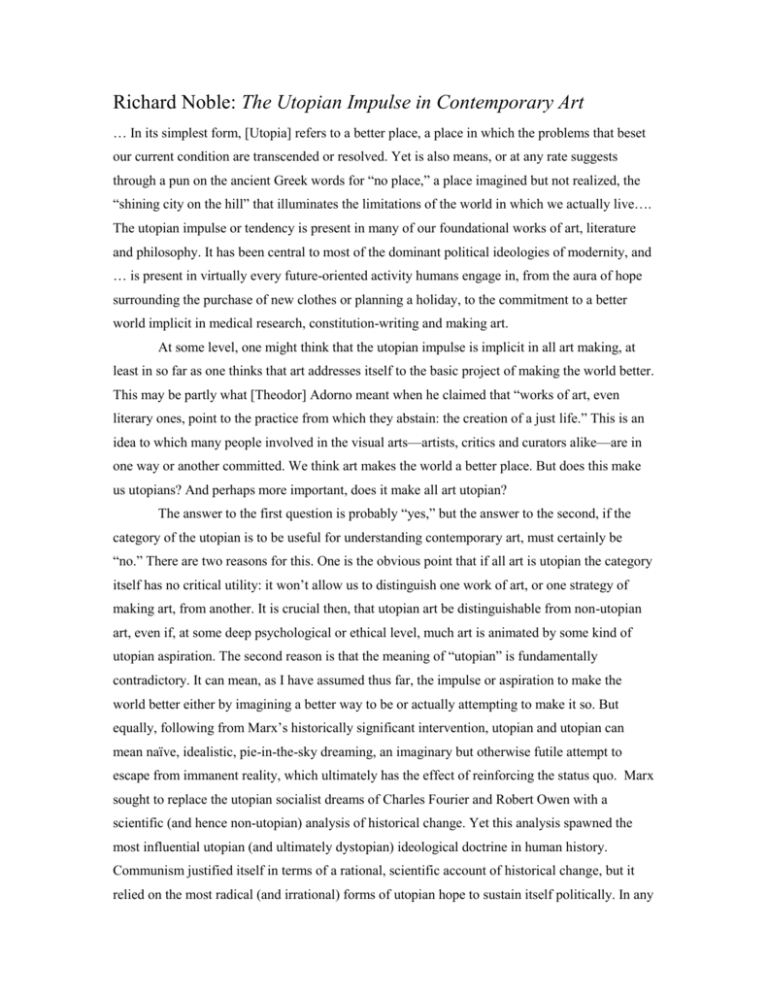
Richard Noble: The Utopian Impulse in Contemporary Art … In its simplest form, [Utopia] refers to a better place, a place in which the problems that beset our current condition are transcended or resolved. Yet is also means, or at any rate suggests through a pun on the ancient Greek words for “no place,” a place imagined but not realized, the “shining city on the hill” that illuminates the limitations of the world in which we actually live…. The utopian impulse or tendency is present in many of our foundational works of art, literature and philosophy. It has been central to most of the dominant political ideologies of modernity, and … is present in virtually every future-oriented activity humans engage in, from the aura of hope surrounding the purchase of new clothes or planning a holiday, to the commitment to a better world implicit in medical research, constitution-writing and making art. At some level, one might think that the utopian impulse is implicit in all art making, at least in so far as one thinks that art addresses itself to the basic project of making the world better. This may be partly what [Theodor] Adorno meant when he claimed that “works of art, even literary ones, point to the practice from which they abstain: the creation of a just life.” This is an idea to which many people involved in the visual arts—artists, critics and curators alike—are in one way or another committed. We think art makes the world a better place. But does this make us utopians? And perhaps more important, does it make all art utopian? The answer to the first question is probably “yes,” but the answer to the second, if the category of the utopian is to be useful for understanding contemporary art, must certainly be “no.” There are two reasons for this. One is the obvious point that if all art is utopian the category itself has no critical utility: it won’t allow us to distinguish one work of art, or one strategy of making art, from another. It is crucial then, that utopian art be distinguishable from non-utopian art, even if, at some deep psychological or ethical level, much art is animated by some kind of utopian aspiration. The second reason is that the meaning of “utopian” is fundamentally contradictory. It can mean, as I have assumed thus far, the impulse or aspiration to make the world better either by imagining a better way to be or actually attempting to make it so. But equally, following from Marx’s historically significant intervention, utopian and utopian can mean naïve, idealistic, pie-in-the-sky dreaming, an imaginary but otherwise futile attempt to escape from immanent reality, which ultimately has the effect of reinforcing the status quo. Marx sought to replace the utopian socialist dreams of Charles Fourier and Robert Owen with a scientific (and hence non-utopian) analysis of historical change. Yet this analysis spawned the most influential utopian (and ultimately dystopian) ideological doctrine in human history. Communism justified itself in terms of a rational, scientific account of historical change, but it relied on the most radical (and irrational) forms of utopian hope to sustain itself politically. In any event, this contradiction is both confusing and productively interesting,… Utopian strategies … range across it: from the various aspirations to build shining cities on the hill to dystopian imaginings intended to critique current social conditions; from small-scale micro-utopian projects to full-on activist engagement with social problems; from detached and often amusing reconstructions of historical utopian moments to parodic manipulations of utopia as an aesthetic form. What does it mean then for a work of art to be utopian? The answer to this is perhaps less straightforward than we might think. It is hard to identify a single aesthetic strategy common to all utopian art, but there are nonetheless forms that tend to recur: the use of the architectural model (Constant Niewenhuys, Dan Graham, Bodys Isek Kingelez, Nils Norman); the use of the manifesto (Guy Debord, Joseph Beuys, Liam Gillick); references to design and technology (Mark Titchner, Pil and Galia Kollectiv, Goshka Macuga); small and large-scale collaborative actions (Beuys, Agnes Denes, Antony Gormley, Jeremy Deller, Rirkrit Tiravanija). There are others, but perhaps what defines art as utopian is not so much a common aesthetic form as an attempt to model in some way the tension between an immanent critique of the present and a future, radically other condition implied by that critique…. In one way or another, most utopian art postulates models of other ways of being. This strategy of modeling possible worlds, “what ifs” and the logical implications of current practices, seems particularly suited to art…. …[A]n additional feature or tendency in utopian works of art… is that they direct our attention to the realm of the political. Imagining a better world entails some sort of critique of the existing one, though of course Marx was right to claim that neither activity will necessarily have the effect of changing anything. In this respect, all utopian art is political…. It is art oriented beyond existing conditions, sometimes to the future, sometimes to the past; it is art that asks us difficult questions about the conditions we live with and the potential we have to change them. …In the middle part of the last century, as Europe struggled to rebuild itself in the aftermath of the Second World War, Marxist revolutionary politics achieved huge significance within the art world. Debord and Pierre Canjuer’s “Culture and Revolutionary Politics” or Constant Nieuwenhuys’ “Our Own Desires Build the Revolution” illustrate the total integration of politics and art in the revolutionary project, and vice versa. As Constant writes: “As a basic task we propose the liberation of social life, which will open the way to the new world—a world where all the cultural aspects and inner relationships of our ordinary lives will take on new meaning…. Therefore any real creative activity—that is, cultural activity—in the twentieth century, must have its roots in revolution.” Three highly contestable assumptions underlie Constant’s utopianism: the belief that bourgeois capitalist society is producing the conditions necessary for a successful socialist revolution; the view that art has a significant role to play within this process; and its logical corollary that art must in some sense be in opposition to the status quo because of its revolutionary potential. Each of these is now “utopian” in the Marxist sense. Yet despite the disappearance of revolutionary aspiration (at least in the West), the underlying structure of avantgardist utopian thinking continues to influence us…. Utopian art, as [Frederic] Jameson conceives it, is politically effective because it focuses the mind on the necessity of a radical (revolutionary) break with what is. “Utopia now better expresses our relationship to a genuinely political future than any current program of action. It forces us precisely to concentrate on the break itself: a meditation on the impossible, on the unrealizable in its own right. This is very far from a liberal capitulation to the necessity of capitalism, however; it is quite the opposite, a rattling of the bars and an intense spiritual concentration and preparation for another stage which has not yet arrived.” This is a controversial claim. It rather narrows the utopian project to those who aspire to model imaginary but radically other worlds, and hangs on, one might argue nostalgically, to the prospect of revolutionary change. Nevertheless, Jameson identifies something all utopian artists share, which is the desire to model alternatives to the way things are, in order to force some sort of engagement with them. Equally, in his utopian commitment to revolution, even if as he admits, a revolution as yet not fully imagined or understood, he identifies a powerful avant-gardist legacy to which many contemporary artists are drawn. How does one imagine or possibly effect radical change when all departures from the liberal/capitalist norm are characterized as dream life? This is the problem to which Thomas Hirschhorn, Pil and Galia Kollectiv, Titchner and WochenKlausur are in their various ways drawn. Hirschhorn’s uncompromising installations express his commitment to make art politically; to challenge his viewers to engage actively with his critique of contemporary life. WochenKlausur, more straightforwardly, adopt art as a practical means of effecting improvement in people’s lives, whereas Pil and Galia Kollectiv and Titchner focus on specific revolutionary moments or strategies within the history of modernism—projects that might be characterized in terms of a desire to reconstitute what we seem to have lost in a new kind of utopian imaginary. …A somewhat different legacy of the utopian avant-garde … [is] “therapeutic utopianism.” As the promise of full-scale political revolution receded in the last century, the prospect of transformation was not so much abandoned as displaced. The confidence of modernist avant-gardes in the revolutionary potential of art gave way to postmodern pluralism, and if not to a greater skepticism about art’s transformative political potential, at least a more localized, contingent and open-ended range of strategies for linking art to political change. A work like Agnes Denes’ Wheatfield: A Confrontation is typical of such strategies. Denes grew two acres of wheat on a landfill site in lower Manhattan. Although it had no explicit political point, it offered a kind of utopian counterpoint to the ecological devastation wreaked by Wall Street. As Denes writes, “Wheatfield … was an intrusion in the Citadel, a confrontation with High Civilization. Then again, it was also Shangri-La, a small paradise, one’s childhood, a hot summer afternoon in the country, peace, forgotten values, simple pleasures.” Joseph Beuys was also significant in this development. Beuys’ utopian ambitions for the total saturation of society by art have become hugely influential. For Beuys, art itself, rather than art allied to a political movement like communism, became the agent of revolutionary change. “EVERY HUMAN BEING IS AN ARTIST who—from his state of freedom, the position of freedom he experiences first-hand—learns to determine the other positions of the TOTAL ARTWORK OF THE FUTURE SOCIAL ORDER.” The influence of Beuys’ utopian aesthetic can hardly be overestimated, not least in contemporary art’s current obsession with the importance of participation. Beuys wanted art to be democratic, open and accessible to the participation of all, because this respects the fundamental equality of persons as creative beings… The utopian aspirations of Beuys echo strongly amongst contemporary artists such as Antony Gormley and Ilya Kabakov. The latter’s Palace of Projects exhaustively investigates the human propensity to construct and execute projects. Like Beuys, Kabakov believes art can find its way into the most mundane human activities, and also that it does so as an agent of liberation, a means of taking every individual beyond the quotidian towards something essentially human. Gormley has also developed a kind of therapeutic utopian strategy in his large-scale participatory works like Field and Domain Field. For Gormley, the activity of making Field, each person following a very simple set of instructions to create a mass of similar yet absolutely individuated forms, models a kind of social contract between artist and collaborators in which everyone is empowered as a creator of the work. More recently, the work of a number of artists associated with Nicholas Bourriaud’s term “relational aesthetics” has developed the therapeutic ideal of participation even further. Liam Gillick’s constructions model the utopian possibilities of democratic life, while Rirkrit Tiravanija’s shared meal installations attempt to create microutopian moments of intersubjective conviviality between participants in an artwork. In all these projects, such forms of participation are proffered as utopian moments in which a different kind of human relationship is modeled: equal, non-instrumental, better….
